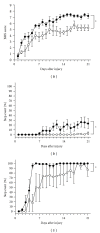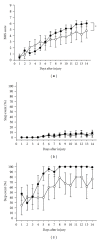Epimedium koreanum Extract and Its Constituent Icariin Improve Motor Dysfunction in Spinal Cord Injury
- PMID: 22956977
- PMCID: PMC3432561
- DOI: 10.1155/2012/731208
Epimedium koreanum Extract and Its Constituent Icariin Improve Motor Dysfunction in Spinal Cord Injury
Abstract
Although cell transplantation strategies for spinal cord injury (SCI) using sources such as iPS cells and neural stem cells are focused as expectative therapies for SCI, the possibility of medication as more accessible and practical way should not be given up. We, therefore, aimed to develop medical sources for SCI. In this paper, we evaluated effects of a famous tonic herb, Epimedium koreanum, on motor dysfunction in spinal cord injury (SCI). The spinal cord was injured by contusion after laminectomy at T10 level. Oral administration of the methanol extract of E. koreanum significantly enhanced hindlimb function in SCI mice by short period treatment (for initial 3 days) and chronic treatment (21 days), although chronic treatment recovered the function more potently. Since it is well known that icariin is the major constituent in E. koreanum, icariin was administered orally to SCI mice for initial 3 days. Motor dysfunction was ameliorated by icariin treatment similarly to the methanol extract of E. koreanum. This paper is the first report to indicate E. koreanum is effective for recovery of motor function in SCI, and at least icariin is an active constituent.
Figures



Similar articles
-
The Effects of Icariin on Enhancing Motor Recovery Through Attenuating Pro-inflammatory Factors and Oxidative Stress via Mitochondrial Apoptotic Pathway in the Mice Model of Spinal Cord Injury.Front Physiol. 2018 Nov 16;9:1617. doi: 10.3389/fphys.2018.01617. eCollection 2018. Front Physiol. 2018. PMID: 30505282 Free PMC article.
-
Effect of lipid-based suspension of Epimedium koreanum Nakai extract on sexual behavior in rats.J Ethnopharmacol. 2007 Dec 3;114(3):412-6. doi: 10.1016/j.jep.2007.08.021. Epub 2007 Aug 19. J Ethnopharmacol. 2007. PMID: 17890032
-
Epimedium koreanum Nakai and its main constituent icariin suppress lipid accumulation during adipocyte differentiation of 3T3-L1 preadipocytes.Chin J Nat Med. 2016 Sep;14(9):671-676. doi: 10.1016/S1875-5364(16)30079-6. Chin J Nat Med. 2016. PMID: 27667512
-
Neuroprotective role of icariin in experimental spinal cord injury via its antioxidant, anti‑neuroinflammatory and anti‑apoptotic properties.Mol Med Rep. 2019 Oct;20(4):3433-3439. doi: 10.3892/mmr.2019.10537. Epub 2019 Jul 30. Mol Med Rep. 2019. PMID: 31432160
-
Epimedium koreanum Extract and Its Flavonoids Reduced Atherosclerotic Risk via Suppressing Modification of Human HDL.Nutrients. 2019 May 18;11(5):1110. doi: 10.3390/nu11051110. Nutrients. 2019. PMID: 31109081 Free PMC article.
Cited by
-
Icariin promotes the repair of PC12 cells by inhibiting endoplasmic reticulum stress.BMC Complement Med Ther. 2021 Feb 19;21(1):69. doi: 10.1186/s12906-021-03233-1. BMC Complement Med Ther. 2021. PMID: 33607999 Free PMC article.
-
Epimedium extract promotes peripheral nerve regeneration in rats.Evid Based Complement Alternat Med. 2013;2013:954798. doi: 10.1155/2013/954798. Epub 2013 Sep 17. Evid Based Complement Alternat Med. 2013. PMID: 24159356 Free PMC article.
-
The Effects of Icariin on Enhancing Motor Recovery Through Attenuating Pro-inflammatory Factors and Oxidative Stress via Mitochondrial Apoptotic Pathway in the Mice Model of Spinal Cord Injury.Front Physiol. 2018 Nov 16;9:1617. doi: 10.3389/fphys.2018.01617. eCollection 2018. Front Physiol. 2018. PMID: 30505282 Free PMC article.
-
Exploring the molecular mechanism of icariin improving spinal cord injury through network pharmacology combined with experimental verification.Naunyn Schmiedebergs Arch Pharmacol. 2025 Aug;398(8):10539-10556. doi: 10.1007/s00210-025-03904-7. Epub 2025 Feb 27. Naunyn Schmiedebergs Arch Pharmacol. 2025. PMID: 40014127
-
Epimedium koreanum Nakai displays broad spectrum of antiviral activity in vitro and in vivo by inducing cellular antiviral state.Viruses. 2015 Jan 20;7(1):352-77. doi: 10.3390/v7010352. Viruses. 2015. PMID: 25609307 Free PMC article.
References
-
- Fehlings MG, Baptiste DC. Current status of clinical trials for acute spinal cord injury. Injury. 2005;36(2):SB113–SB122. - PubMed
-
- Kronvall E, Sayer FT, Nilsson OG. More and more questions about the use of methylprednisolone for the treatment of acute spinal cord injury. Lakartidningen. 2005;102(24-25):1887–1890. - PubMed
-
- Weaver LC, Gris D, Saville LR, et al. Methylprednisolone causes minimal improvement after spinal cord injury in rats, contrasting with benefits of an anti-integrin treatment. Journal of Neurotrauma. 2005;22(12):1375–1387. - PubMed
-
- Okada S, Nakamura M, Katoh H, et al. Conditional ablation of Stat3 or Socs3 discloses a dual role for reactive astrocytes after spinal cord injury. Nature Medicine. 2006;12(7):829–834. - PubMed
-
- Pearse DD, Pereira FC, Marcillo AE, et al. cAMP and Schwann cells promote axonal growth and functional recovery after spinal cord injury. Nature Medicine. 2004;10(6):610–616. - PubMed
LinkOut - more resources
Full Text Sources
Research Materials

